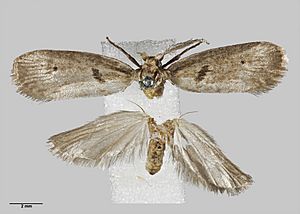Karamu shoot borer facts for kids
Quick facts for kids Karamu shoot borer |
|
|---|---|
 |
|
| Scientific classification | |
| Kingdom: | |
| Phylum: | |
| Class: | |
| Order: | |
| Family: |
Galacticidae
|
| Genus: |
Tanaoctena
|
| Species: |
T. dubia
|
| Binomial name | |
| Tanaoctena dubia Philpott, 1931
|
|
| Synonyms | |
|
|
The Karamu shoot borer or Coprosma shoot borer moth (scientific name: Tanaoctena dubia) is a small moth found only in New Zealand. It belongs to the family Galacticidae. A scientist named Philpott first described this moth in 1931.
Contents
Meet the Karamu Shoot Borer Moth!
This interesting moth is known for its unique appearance and how it interacts with certain plants. It plays a small but important role in the ecosystems of New Zealand.
What Does the Karamu Moth Look Like?
The Karamu shoot borer moth is quite small. Its wingspan is about 18 millimeters (which is less than an inch).
Wings and Colors
The front wings of this moth are a dull brownish color. They have a thick, dark mark that slants inwards. This mark is found about a quarter of the way along the wing. There is also a small, round, dark spot further back on the wing. The back wings are a grayish-brown color.
Where Does the Karamu Moth Live?
This moth is found only in New Zealand. This means it is an endemic species, which makes it special to that country.
What Does the Karamu Moth Eat?
The young moths, called larvae (or caterpillars), feed on plants from the Coprosma family. These plants are often called Karamu.
How Larvae Feed
The larvae have a special way of eating. They first mine the leaves of the Coprosma plants. This means they tunnel inside the leaves, eating the plant material from the inside. But they don't stop there! They also bore into the tips of the growing shoots. When they do this, the shoots can wilt, meaning they droop and become weak.

